From 1,100 Connected Traffic Lights, Smart Cities Will Grow
There are eighty-six seconds before the traffic lights are due to turn from red to green, plenty of time to pull my phone out of my pocket and check Twitter. Fifty-four seconds, and I channel surf on the radio, ignoring the flashing lights and eager billboards of the Las Vegas strip around me. Fifteen seconds, just enough time for a quick gulp of water, and then my hands are ready on the wheel, foot poised on the gas, ready to pull away.
It's a mighty relaxing way to deal with traffic, and though the shiny new Audi I'm driving doesn't exactly hurt when it comes to cosseting, it's the groundbreaking technology baked into this connected car that can really take the credit. Freshly powered-up in Las Vegas, NV, Audi's Traffic Light Information (TFI) is one of the very first steps down the road of Vehicle-to-Infrastructure (V2I). Cars that hold entire conversations with the cities they're driven in, an encrypted back-channel intended to keep the roads flowing and your blood pressure down.
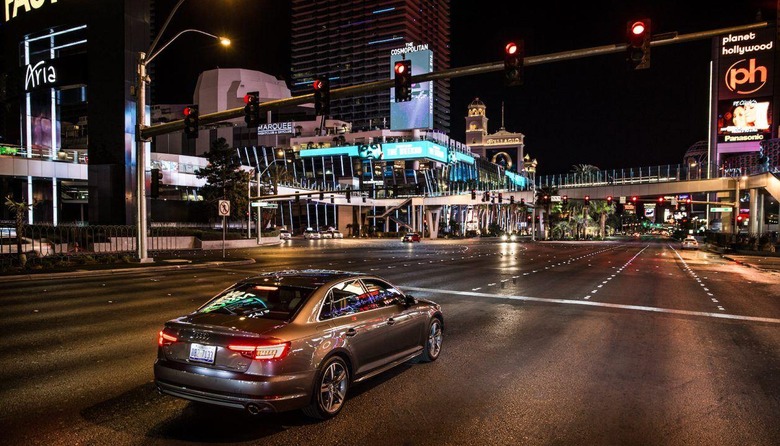
This isn't the first time traffic light information has been served up to drivers, but it's probably the most high-tech. Some countries have timers mounted on the signals themselves; a handful of cities have experimented with (and abandoned) short-range, radio-based systems, the individual lights communicating with compatible cars nearby. There are lifehack-style workarounds, of course, like watching the countdown on pedestrian crossings in the US to figure out when the lights are likely to switch.
The cynics among us could potentially dismiss Audi's Traffic Light Information system as unduly complex, then. That's only if you mistakenly see it as the conclusion of V2I, though, rather than simply the first step in it. Yes, this is a lot of technology to power a simple countdown, but the broader potential of cars that intercommunicate with the cities and highways they utilize is considerable.
TLI is the latest addition to Audi connect, the portfolio of connected car services that the automaker first rolled out in 2011. Since then, the 3G modem has given way to 4G LTE, and there are 43 different features taking advantage of that connection. Core safety tech is included as standard with the car, but Audi charges a subscription for the convenience features in its "connect prime" plan, and finally adds pay-as-you-go WiFi hotspot support in "connect plus".
You'll need "connect prime" at least to get Traffic Light Information; there's a six month subscription to all the plus-level features when you first buy a new Audi. As long as that's the case, and you're in an area where TLI is supported, it's all deceptively straightforward on the dashboard. As you approach the next intersection, a traffic light graphic pops up on the Virtual Cockpit, Audi's digital instrumentation. A countdown tells you how long before the lights turn from red to green.
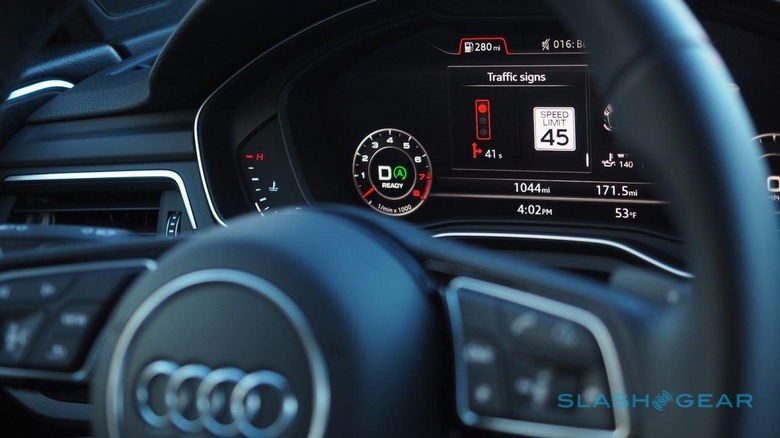
Sometimes, even though the lights ahead are currently green, you still get a timer. That's because the car looks at your current speed and its knowledge of when the signal is due to turn red, and can figure out that, by the time you get there, you'll have to stop. If you indicate in a turn-lane, the TLI system pulls the correct timing data for that turn, which might be different to the through traffic.
Since Audi isn't especially keen on giving wannabe-racing drivers a countdown to launching away from the lights in a cloud of tire smoke, the timer disappears when it gets down to four seconds. The automaker describes it as "informed waiting," and emphasizes the potential calming affect of better understanding how the road system is working. "The driver isn't so focused on the light, thinking it's going to change immediately," Rick Whittemore, Connected Vehicle Portfolio Manager and Audi of America, explains.
While the presentation is simple, there's plenty going on the background. First, the city or regional agency – in this case the Regional Transportation Commission of Southern Nevada (RTC) – provides local traffic signal data to Traffic Technology Services (TTS), an independent company which specializes in telematics. TTS crunches that information, and then sends Audi a detailed map of the intersection along with details on the current signal status, predicted switch time, and the confidence of that prediction.
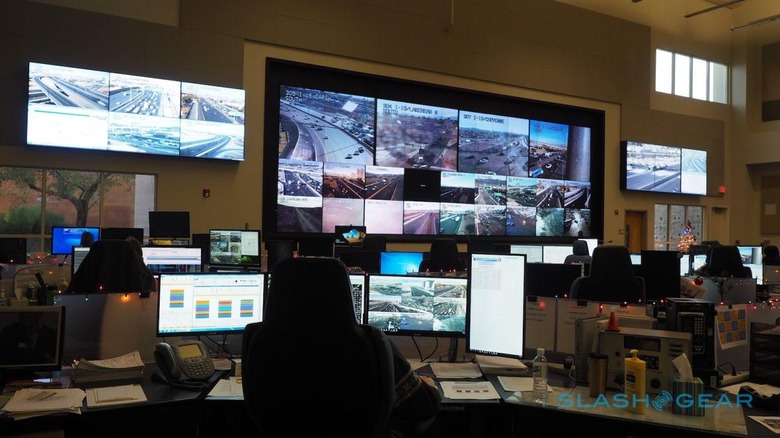
The last part is particularly important, as Audi is playing it cautiously with what could potentially confuse or frustrate drivers. The TLI system only displays a timer if there's a high level of confidence in the timelines. If it's less certain – such as if emergency services have recently passed through, modifying the timings – then nothing pops up onto the car's display.
"We would rather display nothing than display something that's incorrect," Whittemore says. "We err on the side of conservative, on no data rather than incorrect data."
Behind the wheel of a 2017 Audi A4, one of the first cars to offer support for TLI, I was surprised how quickly I came to accept the new information. On the one hand, when you know that the lights are going to change by the time you reach them, you're much more likely to lift your right foot and let the car coast, boosting economy in the process. Meanwhile, with the knowledge that I had more than a minute before the lights were due to change to green, I felt free to turn round and chat with back-seat passengers without worrying I'd miss my turn through the intersection.
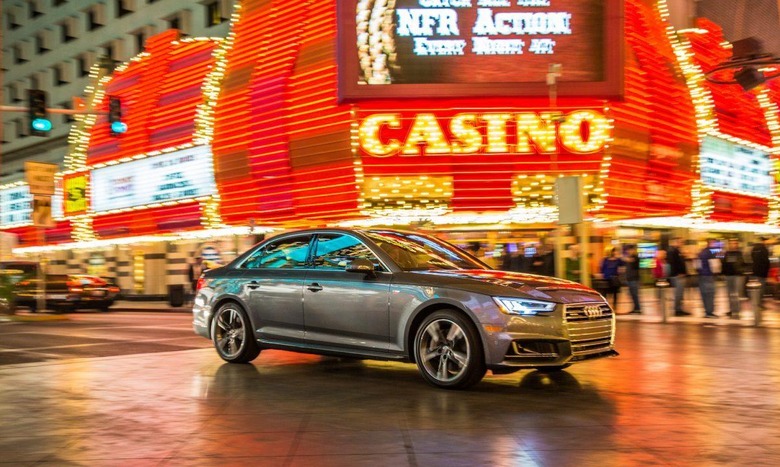
People I've told about TLI have generally fallen into one of two camps. On the one hand, some instantly "get" the idea and why it's useful. Better informed rather than hammering your fingers on the steering wheel, wondering when it'll be your turn to get moving again.
The other group is less enthusiastic. Traffic lights are a fact of life, they point out. Is it really worth the cost of upgrading a city to beam such a minnow of data to the dashboard of a car?
Turns out, the answer to that is "yes, it really is worth it." Take expansion of road systems in city environments: even in somewhere like Las Vegas, where you're surrounded by empty desert, it can still cost upwards of $5m to put in a mile of new, single-lane road where it's truly required. There's not just the asphalt and the earth-movers to consider, but the compulsory purchase of the land involved, the planning and infrastructure investments, and more.
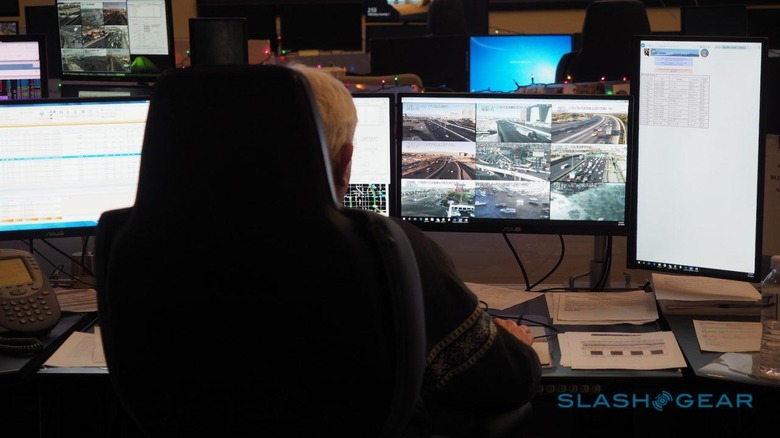
Meanwhile, at a certain point there's not much you can do with the space you have to play with. On something like Las Vegas' iconic strip, for instance, there's only so far you can encroach on either side: then you're forced to build up or down, leading to stacked roadways or alternatively tunnels that are even more expensive both to build and maintain. Try that in a more dense, premium location like a major coastal city, and the costs spiral even higher.
With those sort of numbers, the roughly $500k involved in upgrading Las Vegas' infrastructure to smart lights seems like a drop in the ocean. The technology in each of the traffic signals themselves isn't particularly new or dramatic; indeed, many lights are already connected. And, while a system like TLI may not instantly expand how many vehicles can use a road, it does open up far more flexibility for cities under strain.
"Agencies today have pretty good traffic data on their highways," Audi's Whittemore points out. "They don't have particularly good data on their surface streets." In the case of Nevada FAST (Freeway and Arterial System of Transportation), for instance, there are 70 ramp meters and 504 freeway flow detectors being monitored but, once traffic moves onto the regular streets, there's very little pattern tracking being done.
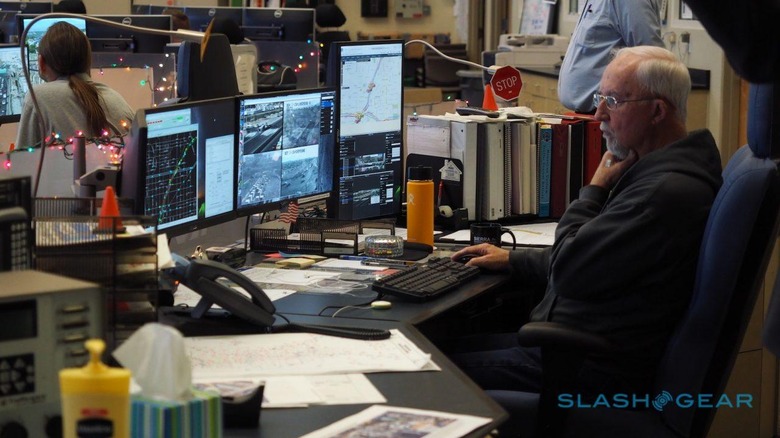
Audi's goal is to feed back into FAST's systems just as frequently as it polls them for traffic light timings. For the moment, it will periodically supply the agency with a data dump of anonymized vehicle movement. That'll include tidbits like how many cars have passed through a set of lights, how long they had to wait, and when during the day was most popular.
In the future, the same data will be reported in real-time, allowing FAST to potentially modify light timings in order to better move traffic around the city and minimize bottlenecks. "What are the routes that people are taking from home, to school, to entertainment," Brian Hoeft, FAST director, asks, "and how can that be improved by traffic movement information?" Similarly, Audi's roadmap for TLI includes incorporating traffic light data into routes served up by its cars' navigation systems, and even controlling when the engine start/stop system kicks in based on how long the wait will be.
A little selfishly, I'm most interested in plans to change the lights at quiet intersections in my favor when there's nobody else around: no more sitting at a red light with zero traffic taking advantage of the green.
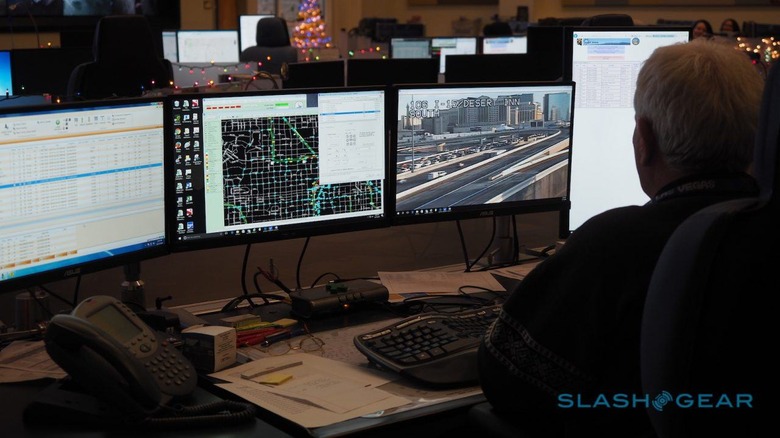
Audi is currently working with a number of other municipalities on lighting up a similar system to what has gone live in Las Vegas, though the company is wary of confirming exactly where might come next or when it could happen. That, Audi's Justin Goduto, Senior Specialist in Product & Technology Communications, told me, is because it's taking longer than anyone really expected to pull all the pieces together. The last thing Audi, Traffic Technology Services, or any of its other partners want is to prematurely get drivers' hopes up and then end up souring that first experience when things don't quite stick to the roadmap.
That's because there's a gulf between recognizing that smart city technology could have vast benefits for urban planning, and actually being anywhere down the line to delivering them. In several cases, Goduto explains, municipalities aren't short on enthusiasm, but face fragmented, only partially-updated, and generally neglected infrastructure. If lights are connected, there can be a mishmash of agencies actually responsible for them: the two sets of signals on either ends of a block can be operated by two completely different organizations.
As a result, though there's some competition to be the next city to go live with TLI, Audi is playing things conservatively. Goduto experienced first-hand just what impact a little information can have, when an Audi buyer called him out of the blue to say he'd cancelled his new Q7 order and was re-ordering the SUV with a later build-date so that it would have TLI compatibility. That's despite not actually living in a place where the service is live, and there being no current roadmap for when that situation may change.
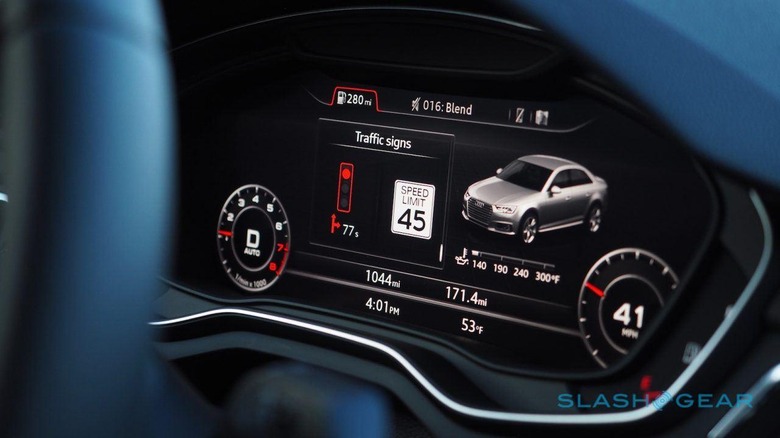
Audi's hope is that other companies decide to get in on the connected car system and that helps accelerate both adoption and city upgrades. Since Traffic Technology Services is an independent middle-man doing the collation of light timings from Las Vegas, and offering the data as an open standard (the SAE J2735 standard DSRC message set, to be exact), there's no reason why other automakers couldn't offer the same sort of thing to their own drivers. It'd be up to them to decide how to integrate traffic light timings in things like navigation and engine start/stop, but the core functionality would be there.
If there's a need for broader support for V2I in general, it's because it'll be instrumental in making autonomous vehicles safer. "In the future we'll do this with a piloted car," Audi's Whittemore suggests, "the piloted car has sensors, they do better than what a human can do, but they have limits. For instance you come up to a bend in a corner, you can't see around that corner, but there's been an accident. In the future, you could get a message from what's going on to know to slow down beforehand."
For all the automaker talk of self-driving cars, we're still some way off from giving up the controls ourselves. Nonetheless, Audi is doing what it can to give as many drivers a taste of the V2I future. It's notable that Traffic Light Information is coming first to Audi's two best-selling mass-market vehicles, the A4 and Q5, in the first wave. The Q7 will get it too, as will the A4 allroad, the A5 and S5 Sportback, and the SQ5, as long as they're built after June 1 this year.
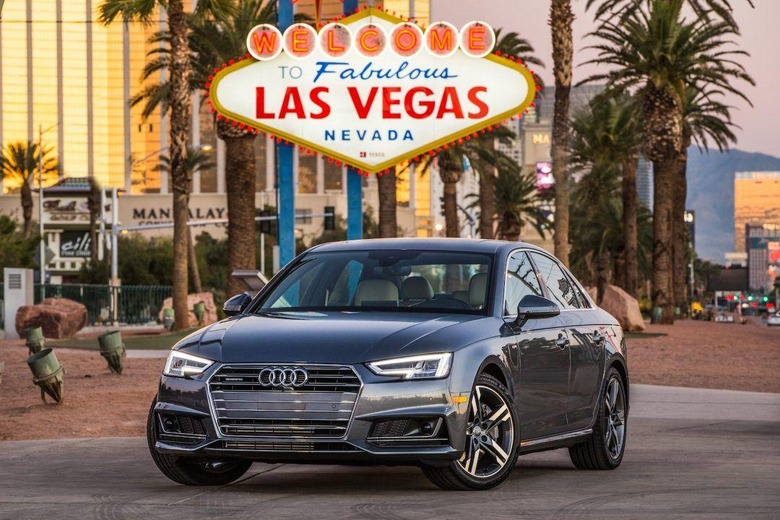
NOW READ: 2017 Audi A4 Review
Today, in Las Vegas, there are around 250 cars that will work with TLI. They're playing an important role in their own right, too, as Audi uses them to validate the data it's getting from TTS. Software to turn TLI on was pushed out over-the-air (OTA), simply popping up on owners' dashboards this week, though Audi's customer services team has been reaching out to explain just what drivers are now seeing.
You can get a taste of it yourself if you've an Audi from the list and an inclination to make a road-trip to Vegas. Alternatively, you could wait for smart city technology to make its inevitable spread across the country, as planners and budget-makers battle to figure out exactly how they can use technology to relieve the increasing pressure in urban transport. Nobody quite knows when that tipping point will come, but at least now the V2I journey is underway.
